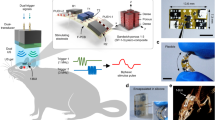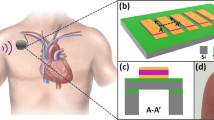Abstract
In this paper, a novel method to generate electrical energy by converting available mechanical energy from pressure fluctuations of the cerebrospinal fluid within lateral ventricles of the brain is presented. The generated electrical power can be supplied to the neural implants and either eliminate their battery need or extend the battery lifespan. A diaphragm type harvester comprised of piezoelectric material is utilized to convert the pressure fluctuations to electrical energy. The pressure fluctuations cause the diaphragm to bend, and the strained piezoelectric materials generate electricity. In the framework of this study, an energy harvesting structure having a diameter of 2.5 mm was designed and fabricated using microfabrication techniques. A 1:1 model of lateral ventricles was 3D–printed from raw MRI images to characterize the harvester. Experimental results show that a maximum power of 0.62 nW can be generated from the harvester under similar physical conditions in lateral ventricles which corresponds to energy density of 12.6 nW/cm2. Considering the available area within the lateral ventricles and the size of harvesters that can be built using microfabrication techniques it is possible to amplify to power up to 26 nW. As such, the idea of generating electrical energy by making use of pressure fluctuations within brain is demonstrated in this work via the 3D–printed model system.










Similar content being viewed by others
References
R. Adolph, H. Fukusumi, N. Fowler, Origin of cerebrospinal fluid pulsations. Am J Phys 212, 840–846 (1967)
L. Beker, O. Zorlu, N. Goksu, H. Kulah, Stimulating auditory nerve with MEMS harvesters for fully implantable and self-powered cochlear implants, in 2013 Transducers Eurosensors XXVII 17th Int. Conf. Solid-State Sensors, Actuators Microsystems (TRANSDUCERS EUROSENSORS XXVII). (IEEE, 2013), pp. 1663–1666. http://ieeexplore.ieee.org/document/6627104/.
L. Beker, B. Eovino, B. Arnau, A.P. Pisano, L. Lin, Piezoelectric pressure energy harvesting using circular diaphragms with concentric ring-boss structures, in Solid-State Sensors, Actuators Microsystems Work (Hilton Head, SC, 2016)
E.R. Cardoso, J.O. Rowan, S. Galbraith, Analysis of the cerebrospinal fluid pulse wave in intracranial pressure. J Neurosurg 59, 817–821 (1983). doi:10.3171/jns.1983.59.5.0817
C. Dagdeviren, B.D. Yang, Y. Su, P.L. Tran, P. Joe, E. Anderson, J. Xia, V. Doraiswamy, B. Dehdashti, X. Feng, B. Lu, R. Poston, Z. Khalpey, R. Ghaffari, Y. Huang, M.J. Slepian, J.A. Rogers, Conformal piezoelectric energy harvesting and storage from motions of the heart, lung, and diaphragm. Proc Natl Acad Sci U S A 111, 1927–1932 (2014) http://www.ncbi.nlm.nih.gov/pubmed/24449853
G. Deuschl, J. Herzog, G. Kleiner-Fisman, C. Kubu, A.M. Lozano, K.E. Lyons, M.C. Rodriguez-Oroz, F. Tamma, A.I. Tröster, J.L. Vitek, J. Volkmann, V. Voon, Deep brain stimulation: Postoperative issues. Mov Disord 21, S219–S237 (2006). doi:10.1002/mds.20957
A. Di Ieva, E.M. Schmitz, M.D. Cusimano, Analysis of intracranial pressure. Neuroscience 19, 592–603 (2013). doi:10.1177/1073858412474845
C. Hamani, A.M. Lozano, Hardware-related complications of deep brain stimulation: A review of the published literature. Stereotact Funct Neurosurg 84, 248–251 (2006) http://www.ncbi.nlm.nih.gov/pubmed/17063047
S.B. Horowitz, M. Sheplak, L.N. Cattafesta, T. Nishida, A MEMS acoustic energy harvester. J Micromech Microeng 16, S174–S181 (2006). doi:10.1088/0960-1317/16/9/S02
G.-T. Hwang, Y. Kim, J.-H. Lee, S. Oh, C.K. Jeong, D.Y. Park, J. Ryu, H. Kwon, S.-G. Lee, B. Joung, D. Kim, K.J. Lee, Self-powered deep brain stimulation via a flexible PIMNT energy harvester. Energy Environ Sci 8, 2677–2684 (2015) http://xlink.rsc.org/?DOI=C5EE01593F
C. Joint, D. Nandi, S. Parkin, R. Gregory, T. Aziz, Hardware-related problems of deep brain stimulation. Mov Disord 17, S175–S180 (2002). doi:10.1002/mds.10161
S. Kimura, S. Tomioka, S. Iizumi, K. Tsujimoto, T. Sugou, Y. Nishioka, Improved performances of acoustic energy harvester fabricated using sol/gel lead Zirconate Titanate thin film. Jpn J Appl Phys 50, 06GM14 (2011). doi:10.1143/JJAP.50.06GM14
Y.-J. Lai, W.-C. Li, C.-M. Lin, V.V. Felmetsger, A.P. Pisano, High-temperature stable piezoelectric aluminum nitride energy harvesters utilizing elastically supported diaphragms, in 17th Int. Conf. Solid-State Sensors, Actuators Microsystems (IEEE, 2013). http://ieeexplore.ieee.org/document/6627257/.
C.-H. Lammers, P.M. Doraiswamy, M.M. Husain, G.S. Fi, S.N. Lurie, O.B. Boyko, E.H. Ellinwood, C.B. Nemeroff, K.R.R. Krishnan, MRI of corpus callosum and septum pellucidum in depression. Biol Psychiatry 29, 300–301 (1991)
M. Mase, K. Yamada, T. Banno, T. Miyachi, S. Ohara, T. Matsumoto, in In Intracranial Press Neuromonitoring Brain Inj. Quantitative Analysis of CSF flow dynamics using MRI in normal pressure hydrocephalus (Springer Vienna, Vienna, 1998). doi:10.1007/978-3-7091-6475-4_101
C. Mo, J. Davidson, W.W. Clark, Energy harvesting with piezoelectric circular membrane under pressure loading. Smart Mater Struct 23, 45005 (2014). doi:10.1088/0964-1726/23/4/045005
B.I. Rapoport, J.T. Kedzierski, R. Sarpeshkar, A glucose fuel cell for implantable brain-machine interfaces Ed. Christophe Egles. PLoS One 7, e38436 (2012) http://journals.plos.org/plosone/article?id=10.1371/journal.pone.0038436
G. Schalk, E.C. Leuthardt, Brain-computer interfaces using Electrocorticographic signals. IEEE Rev Biomed Eng 4, 140–154 (2011) http://ieeexplore.ieee.org/document/6047564/
C.P. Tan, H.G. Craighead, Surface Engineering and patterning using Parylene for biological applications. Materials (Basel) 3, 1803–1832 (2010) http://www.mdpi.com/1996-1944/3/3/1803/
M. Wahbah, M. Alhawari, B. Mohammad, H. Saleh, M. Ismail, Characterization of human body-based thermal and vibration energy harvesting for wearable devices. IEEE J Emerg Sel Top Circuits Syst 4, 354–363 (2014) http://ieeexplore.ieee.org/document/6866930/
Author information
Authors and Affiliations
Corresponding author
Rights and permissions
About this article
Cite this article
Beker, L., Benet, A., Meybodi, A.T. et al. Energy harvesting from cerebrospinal fluid pressure fluctuations for self-powered neural implants. Biomed Microdevices 19, 32 (2017). https://doi.org/10.1007/s10544-017-0176-1
Published:
DOI: https://doi.org/10.1007/s10544-017-0176-1




